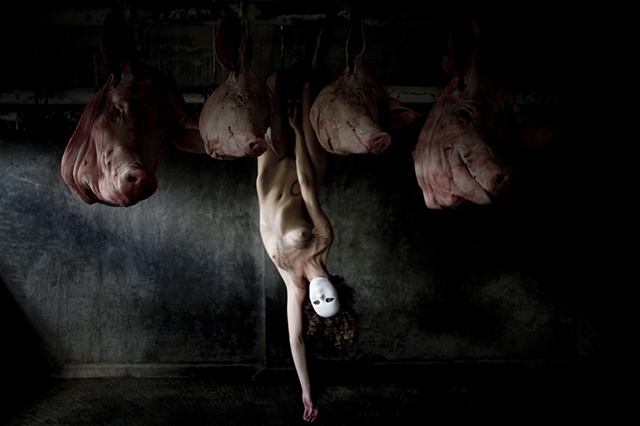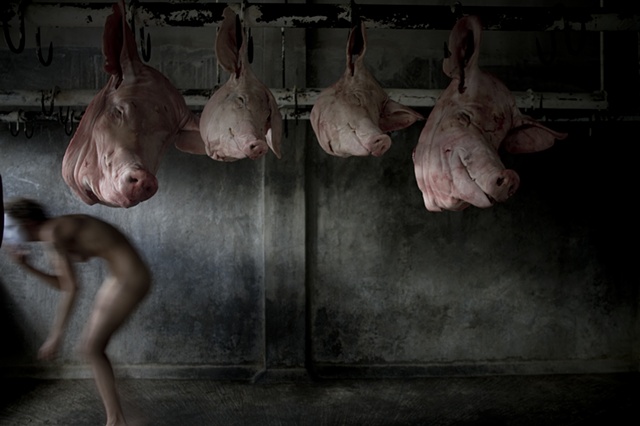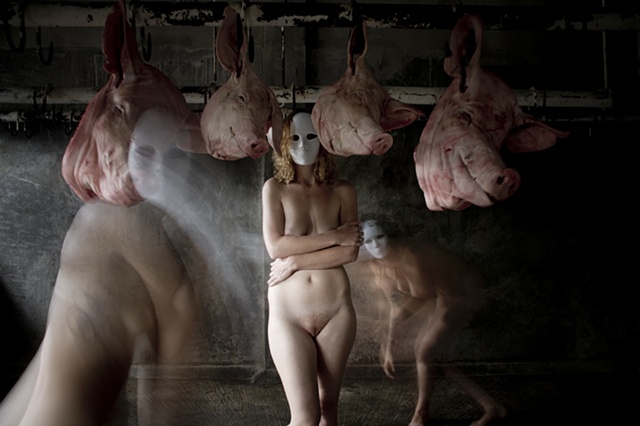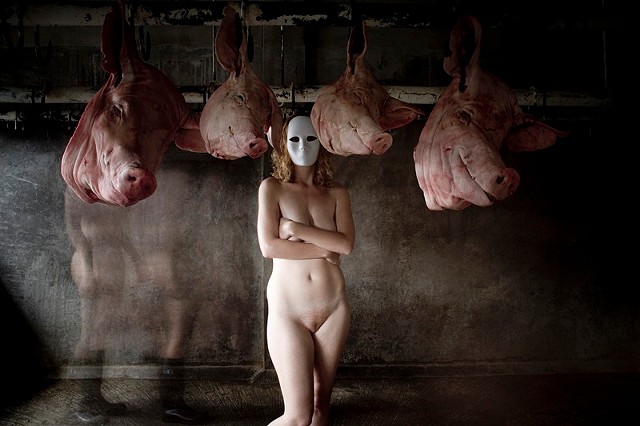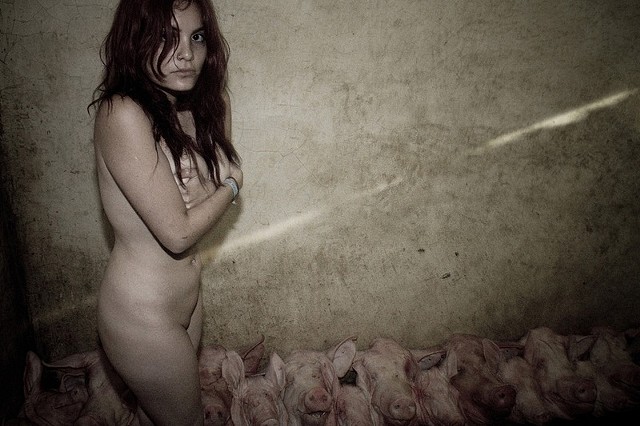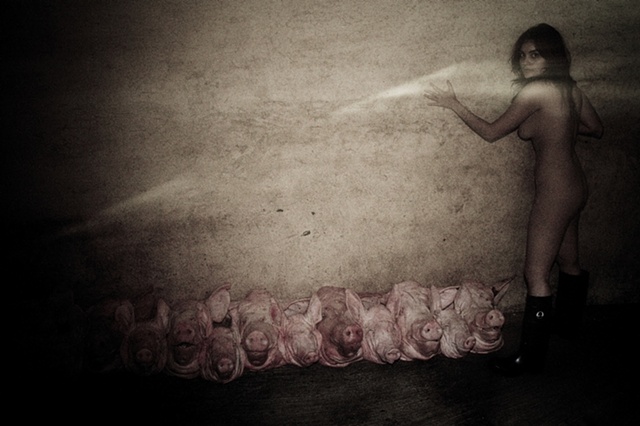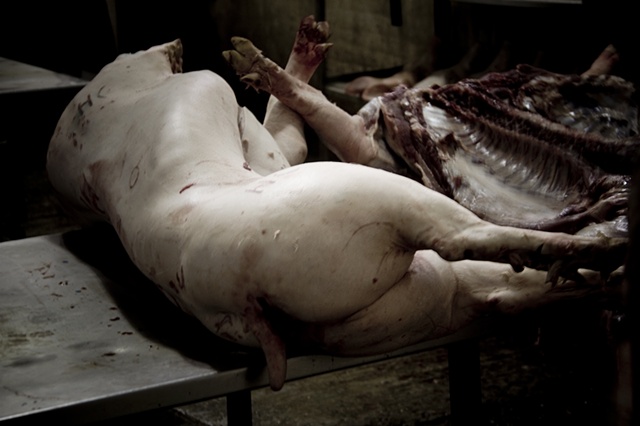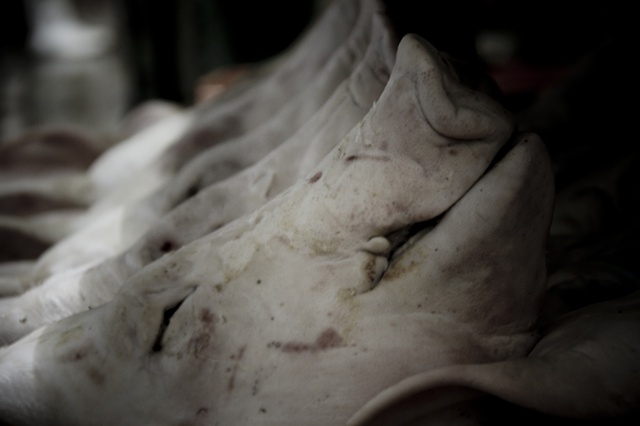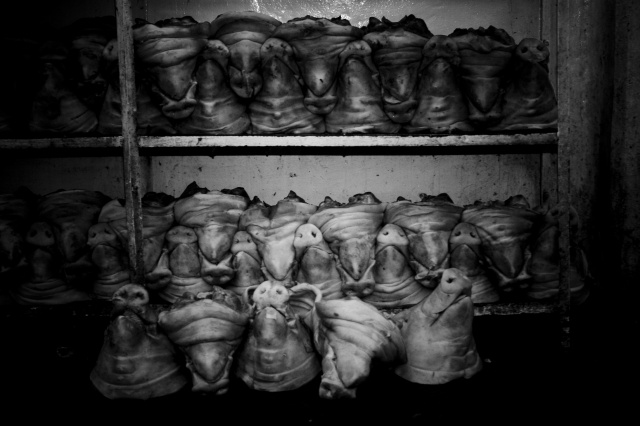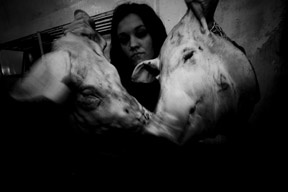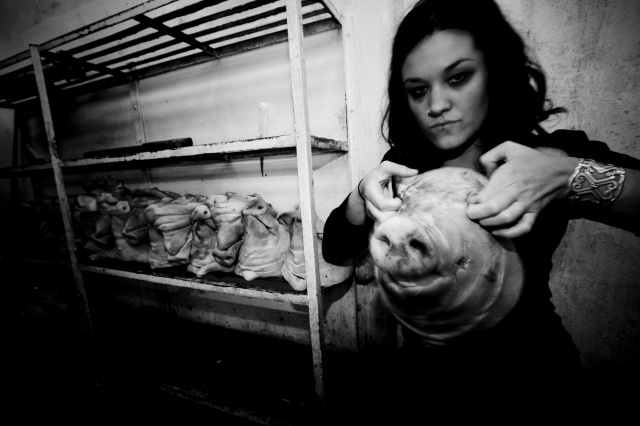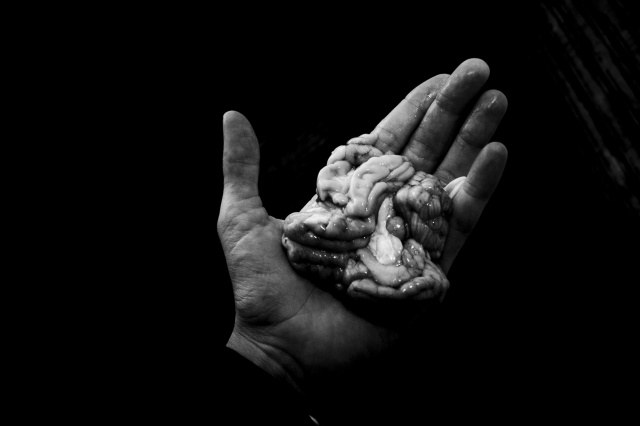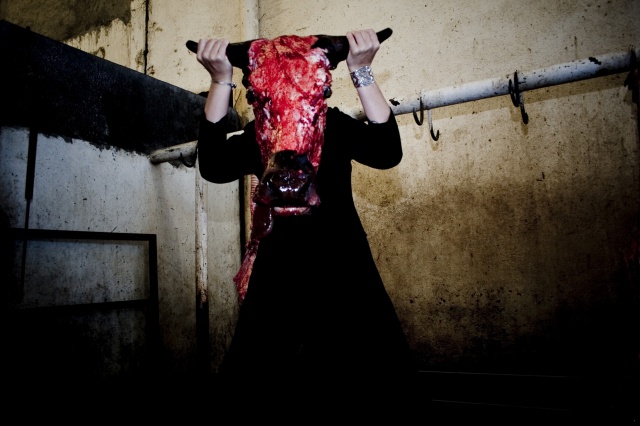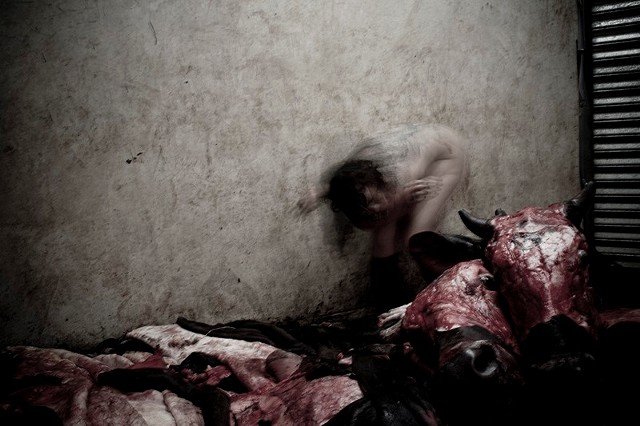FOR CONSUMPTION ONLY (shot 2008 & 2010)
"Macabre at first glance but more intensely revealing with thoughtful scrutiny, the exhibit's photos pair live female forms with their deceased porcine counterparts in such a way that the two become indistinguishable. The monochromatic backdrop of the fully functioning slaughterhouse dramatically highlights the realist flesh tones of both hog and human. Occasional motions in her models, shown by trailing photographic ghosts, inform the viewer that her human subjects are very much alive amid stagnant piles of death. It's raw sexuality juxtaposed with unsettling morbidity."
-LA WEEKLY
From The LA Weekly
August 9, 2012
by Paul T. Bradley
On her first trip inside the slaughterhouse in 2008, photographer Alexandra Gibson had to leave immediately. She sat outside under the Oaxacan sun, unable to bring herself to go in.
Gibson's no wuss. Five minutes with her and you can tell she's not feigning confidence. Patient, maybe. Quiet, perhaps. But cowardly? Not a chance.
She had lost her mother suddenly the year before, and the sense memory of her passing — invoked by the stench of slaughter — couldn't be ignored. The chemicals, meat, blood — the cold result of formerly living beings — gave her serious pause.
Eventually crossing that threshold again took almost an hour of patience. Gibson's courage spawned an artistic journey that would become “For Consumption Only,” a provocative photography exhibit that opened last weekend in Culver City's Skotia Gallery, which relocated here from Santa Fe, N.M., about a year ago.
Gibson had come to Oaxaca, Mexico, in 2008 to work with her mentor, famed photographer Mary Ellen Mark. She wanted to explore hidden regions of the city and document them using a photojournalist's approach. That first trip resulted in a variety of unique photos, but nothing like her current exhibition, which came together in 2011, after three years of percolation.
Macabre at first glance but more intensely revealing with thoughtful scrutiny, the exhibit's photos pair live female forms with their deceased porcine counterparts in such a way that the two become indistinguishable. The monochromatic backdrop of the fully functioning slaughterhouse dramatically highlights the realist flesh tones of both hog and human. Occasional motions in her models, shown by trailing photographic ghosts, inform the viewer that her human subjects are very much alive amid stagnant piles of death. It's raw sexuality juxtaposed with unsettling morbidity.
Gibson insists she is no necrophile. “I was hoping someone would point that out,” she laughs.
The 30-year-old L.A. native is merely fascinated by sexuality and death, and combines that interest with sincere artistic adventurism. She wanted to put, as she says, “the two most consumed objects in modern society into one frame.”
To get herself back to Oaxaca after a three-year absence, Gibson contacted Mark's friend, the man whose family owned the slaughterhouse she had visited. She showed him her work, and he gave her full support to shoot more photos. She and her models required no sneaking around or late-night secrets. “We just had to go before the Meat Board and sign some waivers that promised we wouldn't give the photos to PETA or anything,” she says.
What seemed simpler in Oaxaca may be impossible in the United States, with its state-by-state patchwork of attempts at agricultural media gag laws limiting photography inside meat-production facilities. Given the role that photography played in inspiring California's 2009 attempts to stiffen slaughterhouse regulations, it's unlikely Gibson would be allowed anywhere near a Golden State slaughterhouse with a camera.
Even more astonishing was that she was able to situate her models directly in the midst of production.
“I went in there on the first day, when everything was quiet, and planned out my shots, and then for the rest of the time we were only separated from the full-production slaughter by a sheet of fabric,” she explains of the 10-day shoot.
Nude models were just feet away from 80 workers.
Anyone who has been inside a slaughterhouse can relate to the unrelenting off-kilter sensory assault. When people speak of a “stench of death,” they are not playing with poetry.
Gibson could not ignore her surroundings. “There was a constant sound of shrieking — very real, loud shrieking by the pigs,” she says. “The cows didn't make much noise, but the pigs seemed to be aware of what was happening.
“One day,” she adds, “I was shooting in a room where there were fresh piles of dead cow skins. … The room I was in was so small, so there was no way to avoid looking at it.”
“For Consumption Only” doesn't merely explore questions of consumer cruelty. It also deals with themes such as the distinction between naked and nude — the latter being a state of clotheslessness, the former being unprotected and exposed. To that end, Gibson inserted her own body into the work.
“It was one of the most vulnerable experiences I've ever had,” she says. “I wanted to know what the models were going to go through psychologically. … You're already vulnerable enough getting nude in front of a camera, and then put yourself in a scenario where meat production and slaughter are happening.”
Gibson originally cut her photographic teeth as a purveyor of fine-art erotica, which gave her an impeccable eye for delicious curves, as well as ample license to play with our perceptions of titillation. Her show demonstrates her fearless exploration of all types of bodies, many of them imperfect but all of them alluring.
Oddly enough, there's a twinge of hangman's humor in the exhibit. In the shots where the models don severed pig heads (yes, real dead pigs), corners of hogs' lips curl upward in gruesome grins. “There is this comical lie that's happening,” Gibson says.
Even though neither the work nor the artist makes politics out of art, Gibson says she no longer eats pork. “I just can't do it now, knowing the close texture between pigs and people. … I've since been able to start eating beef, but I probably won't eat pork ever again. It's just too similar.”
Unnecessarily concerned with her own eloquence during our conversations, Gibson made us keenly aware of her meaning in a follow-up email: “I have had a long-term relationship with eating disorders, handled now but in the past. The ugliest thing we learn in humanity is senseless slaughter or the act of murder, the most beautiful thing we know is the naked thin/starved feminine body. Fatten to kill and starve to fuck. Slaughter to consume but then expect women to starve to be consumed.”
Wonderfully put — but said most effectively with her haunting images.
ARTIST STATEMENT:
My interest in shooting nudes in a slaughter house began in 2008 after I first photographed in a slaughter house in Oaxaca Mexico as a means to find a way to face death through art. The initial compulsion to capture the severity of life and death as illustrated by the inner-workings and happenings of a slaughterhouse widened to a universal opportunity for interaction with the nameless fears, disgusts and cultural barriers our society exhibits when exposed to the raw elements of death and the body. My desire is to reinvent this often dehumanized industry of flesh, fur, and bone. "For Consumption Only" is not just a photographic essay on the production of meat; rather it offers confession to the basic terror of existence itself. Furthermore, it requires all who participate, all who see it, to undress their own perceptions of survival and expiration.
Described as “sometimes bizarre, sometimes beautiful – but always layered with deep psychological undertones” by this project’s continued mentor Mary Ellen Mark, I will depict the duality of each theme, regardless of taboo. For the first time since beginning production, I was granted full rights by the slaughter house to explore, shoot and unveil the various layers of dialogue, curiosity and confusion surrounding the process of life and death as it exists within a slaughter house. In 2011 I took this project a step beyond and shoot nudes on location. In this second installation, the focus is on the interaction of a rarely-seen, revealed environment and the human subject. A constructed interaction as such – that of flesh for consumption and flesh of the consumer – will provide a visual point for the discussion and exploration of the fundamental conditions of existence.
There is beauty in death.
There is death in beauty.
